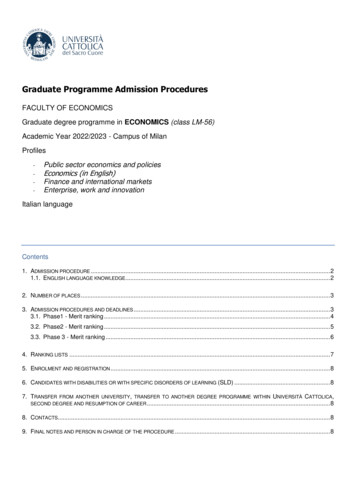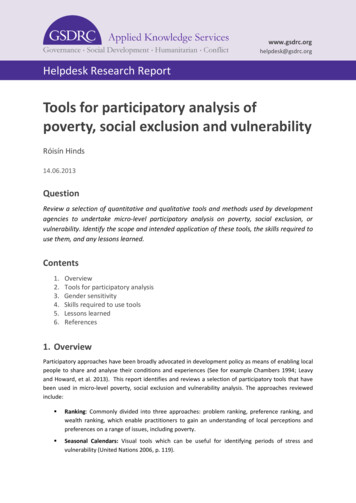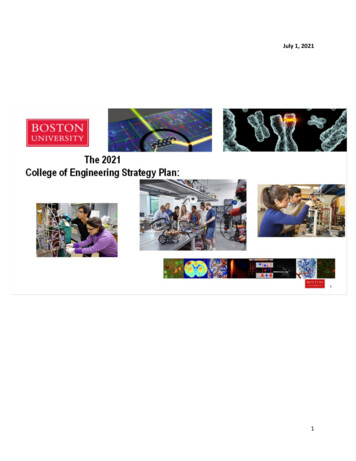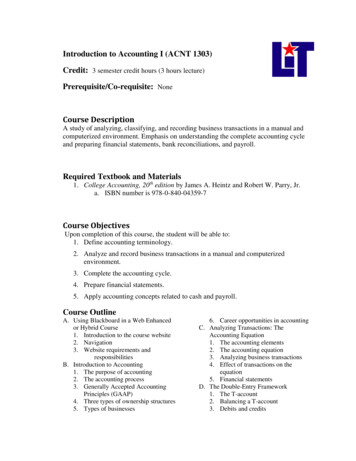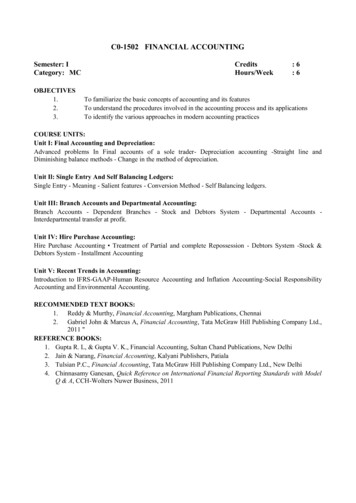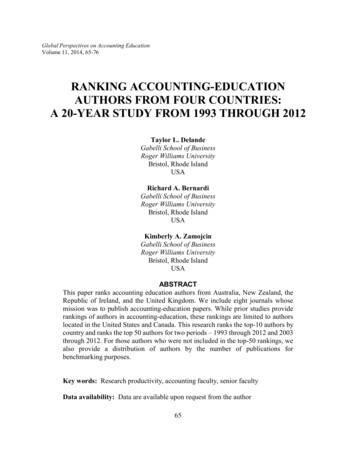
Transcription
Global Perspectives on Accounting EducationVolume 11, 2014, 65-76RANKING ACCOUNTING-EDUCATIONAUTHORS FROM FOUR COUNTRIES:A 20-YEAR STUDY FROM 1993 THROUGH 2012Taylor L. DelandeGabelli School of BusinessRoger Williams UniversityBristol, Rhode IslandUSARichard A. BernardiGabelli School of BusinessRoger Williams UniversityBristol, Rhode IslandUSAKimberly A. ZamojcinGabelli School of BusinessRoger Williams UniversityBristol, Rhode IslandUSAABSTRACTThis paper ranks accounting education authors from Australia, New Zealand, theRepublic of Ireland, and the United Kingdom. We include eight journals whosemission was to publish accounting-education papers. While prior studies providerankings of authors in accounting-education, these rankings are limited to authorslocated in the United States and Canada. This research ranks the top-10 authors bycountry and ranks the top 50 authors for two periods – 1993 through 2012 and 2003through 2012. For those authors who were not included in the top-50 rankings, wealso provide a distribution of authors by the number of publications forbenchmarking purposes.Key words: Research productivity, accounting faculty, senior facultyData availability: Data are available upon request from the author65
66Delande, Bernardi, and ZamojcinINTRODUCTIONcademics are primarily interested in the publication records of their peers because they needto make decisions that are partly based on an assessment of others’ research. For example,an individual might compare themselves to others’ accomplishments when seeking tenureand/or promotion (Beattie and Goodacre, 2004). Consequently, the productivity of individualauthors in accounting research has been assessed by numerous authors (e.g., Chan et al., 2007;Bernardi and Bean, 2010; Urbancic, 2009; Hasselback et al., 2012; Campbell and Morgan, 1987;Zamojcin and Bernardi, 2013). Other publications have examined authors of accounting articles inparticular journals (e.g., Meyer and Rigsby, 2001; Otchere, 2003; Meyer et al., 2005) and theirproductivity in specific research areas (e.g., Bernardi and Bean, 2010; Wilson et al., 2008; Urbancic,2009; Cho and Patten, 2010; Pickerd et al., 2011).Interest in faculty research productivity has recently expanded to include accountingeducation. Urbancic (2009) ranked accounting-education authors using six accounting-educationjournals over a 10-year period; this research ultimately identified authors from 25 countries.Zamojcin and Bernardi (2013) expanded on the number of journals (13 versus six) and the periodconsidered (46 years versus 10 years); however, they only included authors from the United Statesand Canada. The current research provides data on the most prolific authors in accounting educationfrom Australia, New Zealand, the Republic of Ireland, and the United Kingdom in eight of thejournals examined by Zamojcin and Bernardi from 1993 through 2012.1 We provide data on theoverall distribution of authors by the number of education publications as well as the top-50 authorsfor two periods.ALITERATURE REVIEWAuthor RankingsUrbancic (2009) ranked prolific authors in the field of accounting education; however, hisarticle provided data for a 10-year period between 1998 and 2007. Urbancic (p. 21) found thataccounting education provides “a vehicle for scholarly dialogue” across accounting researchworldwide. In addition, Urbancic identified the top 25 accounting-education authors; he also rankedthe top 40 institutional sources for published research.Zamojcin and Bernardi (2013) provided rankings of the most published authors focusing onaccounting education over the 46-year time period 1966 to 2011. Their study was an expansion onUrbancic (2009) who analyzed 868 articles published in six accounting-education journals for a 10year span between 1998 and 2007. Zamojcin and Bernardi expanded the scope of the study byexamining seven additional journals and considering 36 more years. Zamojcin and Bernardi’sresearch developed a benchmark for accounting-education research and a fuller appreciation of theresearch efforts of individual authors and their contributions to the accounting education literaturebase.1We limited our reporting to 1993 through 2012 because of the small number of publications prior to 1992;consequently, we did not include journals that ceased publication (publishing accounting-education research) prior to1993. We also did not include Accounting Education: A Journal of Theory, Practice and Research, AccountingPerspectives (formerly Canadian Accounting Perspectives), and the AIS Educator Journal because there were noarticles by authors from these countries in them. Finally, we did not include the International Journal of AccountingEducation and Research as it ceased publishing accounting-education articles in 1993 and published only oneeducation article in 1993 which was by authors from the U.S.
Ranking Accounting Education Authors from Four Countries67While both of these articles provide a ranking of prolific authors, they provide limited detail(Urbancic, 2009) or only consider research by authors from the United States and Canada (Zamojcinand Bernardi, 2013). Our study is an extension of Zamojcin and Bernardi’s research as it expandsthe inquiry into Australia, New Zealand, the Republic of Ireland, and the United Kingdom. Thepurpose of the study is to provide rankings of the most prolific authors of accounting-educationarticles employed by institutions in Australia, New Zealand, the Republic of Ireland, and the UnitedKingdom. Consequently, our first two research questions are:RQ1: Who are the 10 most prolific accounting authors in the accounting-educationliterature from 1993 through 2012 from each of the following countries:Australia, New Zealand, the Republic of Ireland, and the United Kingdom?RQ2: If one groups all of the accounting authors from Australia, New Zealand, theRepublic of Ireland, and the United Kingdom into one data base, who are the50 most prolific authors in the accounting-education literature from 1993through 2012?General BenchmarkingCampbell et al. (1983) and Hasselback et al. (2000) noted that lists ranking prolific authorsprovide information that could be used as criteria for tenure-or-promotions decisions. Whilenumerous studies have ranked prolific authors by name, many of these studies also provide adistribution of the authors in the journals so that authors who were not ranked by name canbenchmark themselves with others’ accomplishments (Beattie and Goodacre, 2004). During the 20year period included in this research, six articles have ranked accounting’s most prolific authors in:a.b.c.d.e.accounting’s Best 40 journals (Hasselback et al., 2012. p. 954, and 2003. p. 116);24 internationally-recognized accounting journals (Chan et al., 2007. p. 194);22 business-ethics journals (Bernardi, 2005. p. 86);accounting’s Top 40 journals and 26 business-ethics journals (Bernardi and Bean,2010. p. 159); and,13 accounting-education journals (Zamojcin and Bernardi, 2013. p. 197).All of these articles included distributions of all authors by the number of full-credit articlespublished.2 As research can be important to all authors (e.g., Beattie and Goodacre; Campbell et al.;Hasselback et al.) our final research question is:RQ3: What is the distribution of accounting authors, who are employed byinstitutions in Australia, New Zealand, the Republic of Ireland, and theUnited Kingdom, in accounting-education publications by their full-creditarticle counts from 1993 through 2012?2Hasselback et al. (2000. pp. 86-88) provide a similar set of distributions by PhD graduation year. In addition to theoverall distributions above, Hasselback et al. (2012. pp. 949-950, and 2003. pp. 102-104) and Bernardi (2005. p. 6971) also provide distributions by PhD graduation year.
68Delande, Bernardi, and ZamojcinMETHODOLOGYCountries ExaminedTo determine which countries to include in our sample, we used the authors in AccountingEducation: An International Journal.3 Using each of this journal’s tables of contents, we countedthe authors who met our authorship requirements (see below); authors were counted each time theyappeared (i.e., if someone had four articles, they would be counted four times) between 1993 and2012. We identified 211 authors from Australia, 72 authors from New Zealand, 37 authors from theRepublic of Ireland, and 274 authors from the United Kingdom (i.e., a total of 594 authors). Our 594authors represent 85.8 percent of the 692 authors from Accounting Education: An InternationalJournal who were not included in Zamojcin and Bernardi’s study, which suggests that the majorityof English-speaking, international authors come from these four countries. The final 98 (692 - 594)authors (14.2 percent) were not included because either they were not accounting faculty members(i.e., were economists, management, etc.) or were from countries not included in this research.4Journals ExaminedThe initial step in the data gathering process was to identify the journals to include in thestudy. To avoid introducing “substantial subjectivity into the analysis” (Cooley and Heck, 2005, p.51) in identifying accounting-education articles, the scope of this research was limited to journalswith a focus on accounting education. While we searched all 13 journals used by Zamojcin andBernardi (2013), we found that the authors from the four countries in this research published articlesin only eight of these journals (Panel A of Table 1).Search ProceduresThe next step in our search process was to identify accounting-education articles written byaccounting faculty between 1993 and 2012. To be consistent with the methodology in prior research(Urbancic, 2009; Zamojcin and Bernardi, 2013), article counts do not include:Comments and Replies to the Forum Papers, Conference Reports, and Postcardsfrom the Podium in AE; Point/Counterpoint Replies and Rebuttals in IAE; and BetaAlpha Psi Award Winning Manuscripts in JAE. For all journals, Book/Literature andSoftware Reviews are also excluded from the study. (Urbancic, 2009. p. 24)These restrictions are common to Hasselback et al.’s (2012, 2003, and 2000) and Hasselback andReinstein’s (1995) rankings; we did not include editorial introductions to issues. In total, weidentified 446 authors from the four countries between 1993 and the end of 2012.The analysis includes both full-credit articles and coauthor-adjusted articles as ways ofcounting publications. Full-credit article count gives each author on an article “full credit” for the3We used this journal because most (Table 1 - 78.2 percent) of the English language accounting-education articlesfor authors outside the United States and Canada (i.e., Zamojcin and Bernardi’s study) came from this journal.Accounting Education: An International Journal was only used to identify the countries to be included in theresearch; all eight journals were used in our author rankings.4The author count for any of the other countries included in the remaining 98 authors is considerably less than theauthor count for the Republic of Ireland (i.e., 37 authors). South Africa had the next highest number of authors (11).
Ranking Accounting Education Authors from Four Countries69TABLE 1Journals Publishing Accounting Education ArticlesPublication DatesPanel A: Journals used by authors in this studyAccounting Education: An International JournalJournal of Accounting EducationThe Journal of Accounting Case Research*Issues in Accounting EducationAdvances in Accounting EducationAccounting Educators’ JournalGlobal Perspectives on Accounting EducationIMA Educational Case JournalPanel B: Journals not used by authors from the four countriesAccounting Education: A Journal of Theory, Practice and Research*Accounting Perspectives (formerly Canadian Accounting Perspectives)AIS Educator JournalInternational Journal of Accounting Education and Research*The Accounting Review*** Journal ceased publication** Period when journal published accounting education research1992 - Present1983 - Present1991 - 20061986 - Present2002 - Present1988 - Present2004 - Present2008 - Present1996 - 19972002 - Present2006 - Present1966 - 19931966 - 1988authorship regardless of the number of authors. Coauthor-adjusted article count adjusts the article’scredit for the number of authors. For example, if an article had two (three) authors, each authorwould receive one-half (one-third) credit. The data in Figure 1 depict the coauthored-adjustedarticles for the authors from the four countries between 1993 and 2012. The level of coauthoredadjusted education publications decreases slightly between 1993 and 2012.Segmenting the Research Time FrameOur final step was to divide the publications into groupings that provided useful information.In this research, the rankings are divided into two groups - 10 years and 20 years. While the mostrecent 10-year rankings (2003 to 2012) would be useful for new colleagues seeking tenure andpromotion, the 20-year rankings (1993 to 2012) provide evidence of sustained performance in thefield of accounting education.RANKING AUTHORSTop-10 Authors by CountryTable 2 lists the top-10 publishers for each country by their full-credit and coauthoredadjusted article counts. The rankings in Panel A consider the number of full-credit articles; whenties occur in full-credit articles, the number of co-authored adjusted articles was used in the rankingsand if a tie in both measures occurs, the authors are listed in alphabetical order by their last names.The rankings in Panel B consider the number of co-authored adjusted articles, then full-credit article,and finally authors are listed in alphabetical order when these are the same.
Delande, Bernardi, and Zamojcin70FIGURE 1Coauthor-Adjusted Publications from 1993 through 2012Top-50 Accounting-Education AuthorsThe data in Tables 3 and 4 provide productivity benchmarks. In these tables, the normalprogression of ranks is often interrupted, which indicates that two or more authors had the samenumber of full credit and coauthor-adjusted credit for articles. Table 3 lists the top-50 accountingeducation authors identified in this study for the most recent 10 years (2003 to 2012). The rankingsin Panel A consider the number of full-credit articles; when ties occur in full-credit articles, thenumber of co-authored adjusted articles was used in the rankings, and if a tie in both measuresoccurs, the authors are listed in alphabetical order by their last names. The rankings in Panel Bconsider the number of co-authored adjusted articles, then full-credit article, and finally authors arelisted in alphabetical order when these are the same.Table 4 lists the top-50 accounting-education authors for the period from 1993 to 2012. ThePanel A rankings use the number of full-credit articles; the Panel B rankings use co-authoredadjusted credit for articles. Again, the rankings in Panel A consider the number of full-credit articles;when ties occur in full-credit articles, the number of co-authored adjusted articles was used in therankings and, if a tie in both measures occurs, the authors are listed in alphabetical order by theirlast names. The rankings in Panel B consider the number of co-authored adjusted articles, then fullcredit article, and finally authors are listed in alphabetical order when these are the same.Distribution of AuthorsAuthors not identified in Tables 3 or 4 who rank in the top-50 prolific authors can use Table5 as an overall ranking tool to benchmark their education research. This table shows the distributionfor the accounting faculty with publications in education journals. To benchmark their researchproductivity, authors must subtract the cumulative percentage for the group of authors with one lessarticle than they have from 100 percent. For example, an author who has two full-credit articles but
Ranking Accounting Education Authors from Four Countries71TABLE 2Author Rankings by Country (1993-2012)Panel A: Full-credit 5678Country/Author’s NameAustraliaJackling, BeverlyDe Lange, PaulSmith, MalcolmSangster, AlanCraig, RussellWaldmann, ErwinBoland, GregoryHalabi, Abdel K.Mladenovic, RosinaWynder, MontePanel B: Coauthor-adjusted .832.832.502.172.172.172.33123456789New ZealandAdler, RalphMathews, M. R.Milne, Markus J.Tan, Mei LinWeil, SidneyWhittred, GregCarr, Shirley A.Keef, Stephen P.Wynn-Williams, KateWhiting, 1.170.931234Republic of IrelandLarres, Patricia McCourtBallantine, JoanByrne, MarannFlood, BarbaraClarke, PeterWillis, PaulineDoran, JohnHealy, MargaretMcCutcheon, MaeveDonovan, 51.001234United KingdomDuff, AngusPaisey, CatrionaMarriott, NeilPaisey, Nicholas J.Gammie, ElizabethHassall, TrevorBrown, Reva BermanCollison, David J.Marriott, PruStoner, Gregory 83123456789689106789Country/Author’s NameAustraliaSmith, MalcolmJackling, BeverlyDe Lange, PaulSangster, AlanCraig, RussellWaldmann, ErwinWynder, MonteBoland, GregoryHalabi, Abdel K.Mladenovic, .17711108653544New ZealandAdler, RalphMathews, M. R.Milne, Markus J.Whittred, GregTan, Mei LinCarr, Shirley A.Keef, Stephen P.Weil, SidneyWynn-Williams, KateLaswad, 33432Republic of IrelandLarres, Patricia McCourtClarke, PeterBallantine, JoanByrne, MarannFlood, BarbaraDoran, JohnWillis, PaulineDonovan, CecilHealy, MargaretMcCutcheon, 23122United KingdomDuff, AngusBrown, NigelPaisey, CatrionaMarriott, NeilBrown, Reva BermanSimon, JonPaisey, Nicholas J.McChlery, StuartCollison, David J.Marriott, PruStoner, Gregory 6473555
Delande, Bernardi, and Zamojcin72TABLE 3Ten-Year Author Rankings: 2003-2012Panel A: Full-credit 8313334Author’s NameJackling, BeverlyDe Lange, PaulPaisey, CatrionaBallantine, JoanLarres, Patricia M.Paisey, Nicholas J.Byrne, MarannBoland, GregoryFlood, BarbaraGammie, ElizabethDuff, AngusAdler, RalphStoner, Gregory N.Marriott, PruMarriott, NeilBrown, NigelWynder, MonteMathews, M. R.Halabi, Abdel K.Sangster, AlanTan, Mei LinHancock, PhilStevenson, LornaWhiting, RosalindHussain, SimonMcChlery, StuartSimon, JonAisbitt, SallyMcGowan, SueMilner, MargaretDaff, LynJones, AlanCooper, BarryCarr, Shirley A.Clarke, PeterEmmanuel, CliveFreeman, MarkGray, Robert H.Higgs, HelenHill, Wan YangLaswad, FawziLightbody, MargaretMavondo, FelixMcDowall, TracyPaver, BrendaStanley, TrevorTonge, RichardWatty, KimWillett, CarolineWorthington, AustUKAustUKAustPanel B: Coauthor-adjusted 181920212425262931323350Author’s NameJackling, BeverlyDe Lange, PaulPaisey, CatrionaBallantine, JoanLarres, Patricia M.Brown, NigelPaisey, Nicholas J.Duff, AngusByrne, MarannAdler, RalphStoner, Gregory N.Wynder, MonteBoland, GregoryFlood, BarbaraGammie, ElizabethMathews, M. R.Hussain, SimonMcChlery, StuartSimon, JonMarriott, PruHalabi, Abdel K.Marriott, NeilAisbitt, SallyMcGowan, SueMilner, MargaretSangster, AlanTan, Mei LinDaff, LynJones, AlanCooper, BarryHancock, PhilStevenson, LornaCarr, Shirley A.Clarke, PeterEmmanuel, CliveFreeman, MarkGray, Robert H.Higgs, HelenHill, Wan YangLaswad, FawziLightbody, MargaretMavondo, FelixMcDowall, TracyPaver, BrendaStanley, TrevorTonge, RichardWatty, KimWillett, CarolineWorthington, AndrewWhiting, 021.00021.00021.00021.00020.9273
Ranking Accounting Education Authors from Four Countries73TABLE 4Twenty-Year Author Rankings: 1993-2012Panel A: Full-credit 72830313233343536383941424347Author’s NameJackling, BeverlyDe Lange, PaulLarres, Patricia M.Duff, AngusAdler, RalphPaisey, CatrionaMarriott, NeilSmith, MalcolmSangster, AlanPaisey, Nicholas J.Ballantine, JoanByrne, MarannGammie, ElizabethHassall, TrevorMathews, M. R.Brown, Reva BermanCraig, RussellMilne, Markus J.Flood, BarbaraClarke, PeterCollison, David J.Marriott, PruStoner, Gregory N.Waldmann, ErwinBoland, GregoryBrown, NigelSimon, JonHalabi, Abdel K.Mladenovic, RosinaStevenson, LornaTan, Mei LinLewis, SarahWeil, SidneyPower, David M.McChlery, StuartLucas, UrsulaWhittred, GregWynder, MonteLightbody, MargaretLymer, AndrewHand, LenCooper, BarryCarr, Shirley A.Haslam, JimKeef, Stephen P.Wilson, Richard M.S.Emmanuel, CliveEvans, PatriciaGallhofer, KPanel B: Coauthor-adjusted 20232425262728303132343537394041424347Author’s NameDuff, AngusSmith, MalcolmJackling, BeverlyDe Lange, PaulAdler, RalphMathews, M. R.Larres, Patricia M.Brown, NigelPaisey, CatrionaSangster, AlanMarriott, NeilBrown, Reva BermanSimon, JonPaisey, Nicholas J.Clarke, PeterBallantine, JoanByrne, MarannMcChlery, StuartCraig, RussellCollison, David J.Marriott, PruStoner, Gregory N.Gammie, ElizabethHassall, TrevorMilne, Markus J.Flood, BarbaraWaldmann, ErwinLucas, UrsulaWhittred, GregWynder, MonteBoland, GregoryHalabi, Abdel K.Mladenovic, RosinaStevenson, LornaLightbody, MargaretLymer, AndrewChia, Yew MingHussain, SimonTan, Mei LinHand, LenLewis, SarahCooper, BarryCarr, Shirley A.Haslam, JimKeef, Stephen P.Wilson, Richard M.S.Aisbitt, SallyBerry, AidanDrake, 021.5002(Continued)
Delande, Bernardi, and Zamojcin74TABLE 4 (continued)Gray, Robert H.Martin, ElaineTempone, IreneUKAustAust3331.3331.3331.333Dyson, John R.Gray, IainHoque, ZahirulMcGowan, SueMilner, MargaretMoon, PhilipRouse, 001.5002222222TABLE 5Distribution of Accounting Authors with Education PublicationsPanel ATen-year distribution: 2003-2012Number of NumberPercent of Cumulativearticles of %99.2%810.4%99.6%900.0%99.6%1010.4%100.0% 1100.0%100.0%Total261Panel BTwenty-year distribution: 1993-2012NumberPercent of Cumulativeof 40.9%99.4%10.2%99.6%10.2%99.8%10.2%100.0%446is not listed in Panel A of Table 3 because they have fewer than one coauthored adjusted article canindicate that he/she is in the top 25.3 percent (Panel A of Table 5: 100 - 74.7) of the accountingeducation authors between 2003 and 2012 for full-credit education articles. Likewise, an author whohas three full-credit articles but is not listed in Panel A of Table 4 because they have fewer than1.333 coauthored adjusted articles can indicate that he/she is in the top 13.4 percent (Panel B ofTable 5: 100 - 86.6) of the accounting-education authors between 1993 and 2012 for full-crediteducation articles.DISCUSSIONThis paper makes a significant contribution to the existing literature by Urbancic (2009) andZamojcin and Bernardi (2013). While Urbancic included data for only 10 years and listed the top25 (35) authors (adjusted authors) in six journals, Zamojcin and Bernardi included data for 46 yearsand listed the top 50 authors in 13 journals from the United States and Canada. This researchincludes authors from Australia, the Republic of Ireland, New Zealand and the United Kingdom for20 years and lists the top 50 authors in eight of the 13 journals we searched, which were also
Ranking Accounting Education Authors from Four Countries75included in Zamojcin and Bernardi. Consequently, it provides recognition to the authors from thesecountries not included in the other two studies.The data in this study expands on Zamojcin and Bernardi’s (2013) previous research efforts;as such, this study provides decision makers with an appreciation of the research efforts of authorsfrom the four countries included in this study and their contributions to the accounting-educationliterature. The data in this study provide a benchmark for productivity in education research that canbe used in tenure and promotion decisions. For example, authors appearing in this research caninclude this in their promotion and/or tenure review files as external validation of their scholarship.Additionally, the data also provide a source for comparing research productivity in the area ofeducation for deans and other decision makers.The limitations of this study represent opportunities for future research. Our first limitationis that we used data from eight accounting-education journals understates the contributions ofauthors who publish their research in journals other than those included in this study (Christensenet al., 2002). Acceptable-publication outlets might vary with the mission of the institution;consequently, a second limitation is that we did not consider differences in institutional missions(i.e., teaching versus research). Future research could examine whether accounting faculty membersat schools that indicate their primary mission is teaching actually publish more articles in journalsthat specialize in accounting education than faculty at research institutions. Typically researchinstitutions enjoy more external sponsorship (i.e., named professorships or endowed researchchairs); this suggests a third limitation - individual faculty recognition. Future research couldexamine whether or not individuals identified in this research are endowed research chairs or havenamed professorships in accounting education. Named professors/endowed chairs are usually seniorfaculty members, which suggests a final limitation; we did not consider the amount of time sincean author received his/her doctorate. Another view would be to take into account both the length oftime over which each author had been researching in the field and/or the proportion of each author’sresearch effort devoted to this field (as opposed to other fields of research). This represents asignificant expansion of the scope of this research and is similar to studies that have ranked PhDprograms (i.e., taking into account the number of graduates and time since graduation).REFERENCESBeattie, V., and A. Goodacre. 2004. Publishing Patterns within the UK Accounting and FinanceAcademic Community. British Accounting Review (Vol. 36, No. 1) 7-44.Bernardi, R. A. 2005. Accounting Scholars Publishing in Business Ethics Journals: A Thirty-YearLongitudinal Study. Research on Professional Responsibility and Ethics in Accounting (Vol. 10)63-93., and D. F. Bean. 2010. Ranking North American Accounting Scholars Publishing EthicsResearch: 1986 through 2008. Research on Professional Responsibility and Ethics in Accounting(Vol. 14) 139-174.Campbell, D. R., J. Gaertner, and R. P. Vecchio. 1983. Perceptions of Promotion and TenureCriteria: A Survey of Accounting Educators. Journal of Accounting Education (Vol. 1, No. 1)83-92., and R. G. Morgan. 1987. Publication Activity of Promoted Accounting Faculty. Issues inAccounting Education (Vol. 2, No. 1) 28-43.Chan, K. C., C. R. Chen, and L. T. W. Cheng. 2007. Global Ranking of Accounting Programmesand the Elite Effect in Accounting Research. Accounting & Finance (Vol. 47, No. 2) 187-220.
76Delande, Bernardi, and ZamojcinCho, C. H., and D. M. Patten. 2010. Social and Environmental Accounting in North America: AResearch Note. Sustainability, Environmental Performance and Disclosures. Advances inEnvironmental Accounting & Management (Vol. 4) 161-177.Christensen, A. L., C. A. Finger, and C. K. Latham. 2002. New Accounting Scholars’ Publicationsin Nonaccounting Journals. Issues in Accounting Education (Vol. 17, No. 3) 233-251.Cooley, P. L., and J. L. Heck. 2005. Prolific Authors in the Finance Literature: A Half Century ofContributions. Journal of Finance Literature (Vol. 1, No. 1) 46-69.Hasselback, J. A., and A. Reinstein. 1995. Assessing Accounting Doctoral Programs by TheirGraduates’ Research Productivity. Advances in Accounting (Vol. 13, No. 1) 61-86., , and M. Abdolmohammadi. 2012. Benchmarking the Research Productivityof Accounting Doctorates. Issues in Accounting Education (Vol. 27, No. 4) 943-978., , and E. S. Schwan. 2000. Benchmarks for Evaluating the
The Journal of Accounting Case Research* 1991 - 2006 Issues in Accounting Education 1986 - Present . Global Perspectives on Accounting Education 2004 - Present IMA Educational Case Journal 2008 - Present Panel B: Journals not used by authors from the four countries Accounting Education: A Journal of Theory, Practice and Research* 1996 - 1997


